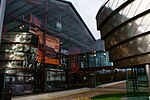Langloan Cricket Ground
CoatbridgeCricket ground stubsCricket grounds in ScotlandScottish sports venue stubsSports venues in North Lanarkshire
Langloan Cricket Ground is a cricket ground in Coatbridge, Scotland. The first recorded match held on the ground came in 1860 when Colonel Buchanan's Scotland Team played Ireland. The ground held its first first-class match when Scotland played Ireland in 1980. The ground held a further first-class match in 1985 when Scotland played the touring Zimbabweans.The ground is still in use today by Drumpellier Cricket Club.
Excerpt from the Wikipedia article Langloan Cricket Ground (License: CC BY-SA 3.0, Authors).Langloan Cricket Ground
Drumpellier Avenue,
Geographical coordinates (GPS) Address Nearby Places Show on map
Geographical coordinates (GPS)
| Latitude | Longitude |
|---|---|
| N 55.858983333333 ° | E -4.0477527777778 ° |
Address
Drumpellier Avenue
Drumpellier Avenue
ML5 1JS , Drumpellier
Scotland, United Kingdom
Open on Google Maps








